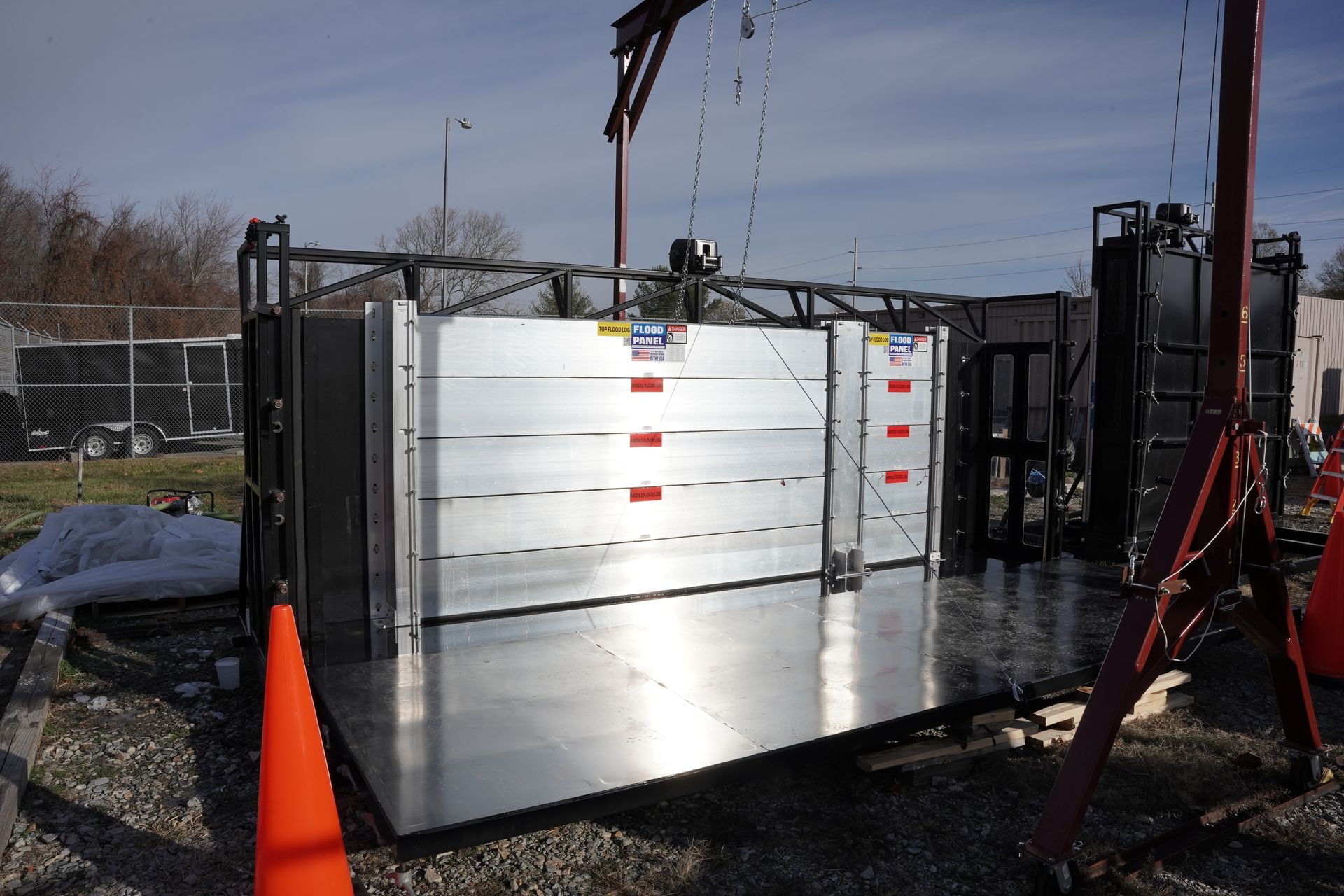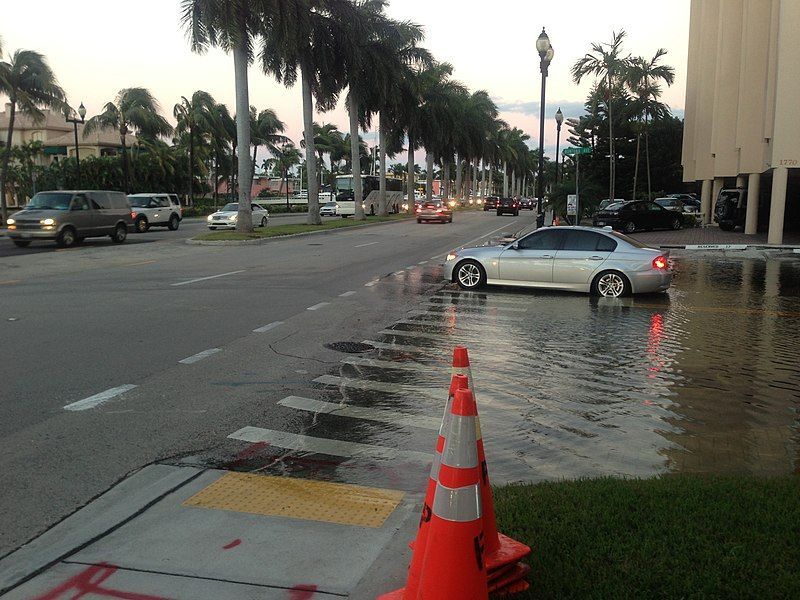Call Us Today - 1 (860) 222-3055
Page 29
Media Contact
Email: media@floodpanel.com
If the site is in an area of low to medium flood risk, less stringent protections may be utilized. One of the most important steps is to ensure that valuable items are stored in an elevated location. For example, an electronics shop located in a flood plain would ideally have automatic flood panels that will protect the inventory around the clock. Even so, the valuable stock should be kept high off the floor, in store rooms on the higher floors, rather than in a basement.
Flood panels, removable or automatic, can easily protect the premises from waters a meter high or more. These panels give the business owner valuable time to move the inventory to a safer location, and will greatly reduce risk — as well as flood insurance premiums.
No matter how well protected, there are catastrophic events that may overwhelm even the most prepared business. In this case, a second line of defense is required. In this situation, a business owner must be prepared to save inventory and equipment by raising it above the water level. This requires advance planning! The business should be equipped with shelves and storage areas high above the historic floodwater levels. Flood panels or barriers can buy the time needed to relocate the valuable items, but there must be a safe place to store the items until the water recedes.
After the floodwaters drain away, a prudent business owner must be prepared for major cleanup. If the owner is well-prepared and/or lucky, most of the inventory has been saved. Now the hard work of cleaning up the mess begins. Will you, as the business owner, be looking up flood damage services on the Internet along with hundreds or thousands of others? Or will you have made arrangements in advance with a reliable service that will put your business first in that long waiting list for emergency cleanup services? Advance planning,
As is evidenced by the recent significant expansion of the FEMA floodplain maps, flood risk is on the increase nationwide. It does not matter whether the increased risk is from climate change, new construction in risky areas, or sea level rise. The fact remains that more and more properties are now located in areas of high flood risk, and the threat of flood loss to residential and business property alike is increasing.
While many business owners rightfully fear and protect against fire damage and loss, it is in fact much more likely that the business will suffer flood-related loss than fire-related loss. And yet, many businesses are woefully under-protected for flood damage! In this week’s post, we will examine some ways that prudent business owners can proactively defend their property against flood loss.
The first step might be to assess the area in which the property is located. If the property is located within the FEMA floodplain map, strong flood prevention measures should be taken. These may include the installation of automatic flood barriers or flood panels, construction of protective berms, or even moving the business to a safer zone.
If the site is in an area of low to medium flood risk, less stringent protections may be utilized. One of the most important steps is to ensure that valuable items are stored in an elevated location. For example, an electronics shop located in a flood plain would ideally have automatic flood panels that will protect the inventory around the clock. Even so, the valuable stock should be kept high off the floor, in store rooms on the higher floors, rather than in a basement.
Flood panels, removable or automatic, can easily protect the premises from waters a meter high or more. These panels give the business owner valuable time to move the inventory to a safer location, and will greatly reduce risk — as well as flood insurance premiums.
No matter how well protected, there are catastrophic events that may overwhelm even the most prepared business. In this case, a second line of defense is required. In this situation, a business owner must be prepared to save inventory and equipment by raising it above the water level. This requires advance planning! The business should be equipped with shelves and storage areas high above the historic floodwater levels. Flood panels or barriers can buy the time needed to relocate the valuable items, but there must be a safe place to store the items until the water recedes.
After the floodwaters drain away, a prudent business owner must be prepared for major cleanup. If the owner is well-prepared and/or lucky, most of the inventory has been saved. Now the hard work of cleaning up the mess begins. Will you, as the business owner, be looking up flood damage services on the Internet along with hundreds or thousands of others? Or will you have made arrangements in advance with a reliable service that will put your business first in that long waiting list for emergency cleanup services? Advance planning, pre-installed flood panels, and above all, preparedness will make the difference between inconvenience and disaster.
Source:: FloodBarrierUSA
Flooding during the months of June and July in the year 2008 devastated great swaths of the US Midwest and forever changed lives in that region. Heavy precipitation in the preceding weeks caused major rivers to swell beyond their banks, breaching levees and other flood barriers. Neighborhoods were underwater for weeks at a time, and damage was estimated in the tens of billions. In addition to the financial impact, 13 lives were lost to the floods.
Washington, D.C., June 20, 2008 — FEMA Deputy Administrator and Chief Operating Officer Harvey Johnson (c) held a press conference on the Midwest floods along with officials from the Environmental Protection Agency, the US Dept of Agriculture, US Army Corps of Engineers, USDA and other federal partners at FEMA Headquarters. Glen Keppy (r), Farm Service Agency Associate Administrator for Programs, USDA, Ed Hecker (l), US Army Corps of Engineers. Bill Koplitz/FEMA
In the six years since that horrible summer, much has been done to prevent a repeat of the destruction. Since flooding is a natural and inevitable event, much of the new work is intended to tame, rather than to prevent floods.
One of the most obvious and important features of the recent improvement efforts has been to improve the flow of the major rivers. This is done in many ways. Dredging of channels is a fundamental improvement, and one that is an ongoing project. After a major flooding event, river basins are usually left full of debris, sediment, and vegetation. All this debris must be cleared and removed. The invasive vegetation is uprooted and destroyed, and sediment must be relocated. Sometimes the sediment may be used in the construction of levees and embankments.
Another recent improvement focus has been on a technique called “daylighting”. In this process, pipes and tubes that had been previously placed underground have been opened up to the sky. During the floods of 2008, many of these pipes were overwhelmed, and contributed to the flooding problem because they were blocked, clogged, or just too small in diameter. Now, many of these waterways have been “day lighted”, enabling them to channel more water during critical moments.
Levees and other flood barriers around the major US rivers have now been rebuilt and beefed up. New dams have been built where needed, and low-lying communities have been provided with berms and flood defenses. This is no small undertaking- the system of levees and other flood barriers for the Mississippi River alone is over 2000 miles long!
In addition to the bank-side levees, a system of setback levees have been put into place. These are levees that are far from the river — in some cases by as much as five miles. During a major flood, the river breeches its immediate levees and is permitted to inhabit the land up to the secondary, or setback levees.
In spite of the best efforts of the US Army Corps of Engineers, floods are never completely controllable, and a sturdy system of levees and other flood barriers can sometimes increase the risk of a major disaster. This happens because the natural floodplains are eventually subjected to development — since these areas are usually dry, the temptation to build homes and businesses overwhelms common sense. People seem to feel that the levees will forever protect them from disaster, but that is not the case. Floods will inevitably occur, and levees will inevitably be breeched. For this reason, natural floodplains should never be developed, but rather maintained as an important defense against catastrophic flooding.
The major rivers of the US Midwest will flood again and again throughout history. This fact cannot be altered. But the recent improvements along the rivers’ routes will help to prevent loss of life and alleviate property damage for a few years at least. Then it will be time to do it all again.
Source:: FloodBarrierUSA 2
Flash floods last week in the states of Arizona and Nevada have smashed records and have caused major damage and chaos throughout the region. Two people in the Tucson area died as a result of the flooding, including a 76-year-old woman who was swept away after her car was lifted by the rushing water.
Another woman was killed when her car was completely submerged on a flooded road. Rescuers tried desperately to free her in time, but the woman was already dead when they managed to pull her from the car. The roiling water that covered this road was said to be up to 12 feet deep.
In addition to countless surface roads affected by the flooding, a large section of I-15 was completely washed away, leading to horrific traffic snarls and impeding the movement of rescue vehicles. The Governor of Arizona immediately declared a state of emergency, and schools were closed in an attempt to minimize loss of life.
September 5 2014, National Aeronautics and Space Administration, LANCE-MODIS
The flooding is being blamed on Hurricane Norbert, which formed near Mexico and then moved north in an uncharacteristic fashion. The storm was still dangerous for days, moving northeast, bringing flooding and dangerous conditions to other areas as meteorologists had predicted.
In Phoenix, precipitation records that go back to the year 1895 were smashed. The area recorded more rainfall in one 24-hour period than has ever before been recorded — with more rain in that one day than the area usually records in the entire months of July, August, and September. The total precipitation for the day was 3.29 inches, while the record from the previous record-holding year, 1895, was 2.91 inches.
While 3 inches of rain does not sound like enough precipitation to cause the kind of massive damage that occurred that week, it must be remembered that in this type of arid topography, any rain that falls immediately runs off the land — it simply cannot be absorbed by the rock-dry ground. Although the cities of Tucson and Phoenix have put flood barriers and run-off channels into place, theses defenses were nearly overwhelmed. During this storm, several critical dams and other flood barriers came within inches of being breached. The fact that the flood barriers held up prevented many more deaths in the region.
While these regions typically struggle with seasonal monsoons, the monsoon rains are usually more localized and do not affect all of the region at once. With a large area affected, there is nowhere for the run-off to go; this is what caused the disaster during that week. It does not bear thinking about what would have happened had the region not had flood barriers and run-off channels in place. A major disaster occurred in Nevada and Arizona, but it could have been much, much worse.
Source:: FloodBarrierUSA 2

Tell us about your project
We look forward to the opportunity to earn your business and to become a value-added partner on your design and construction team.
Contact Us
Contact Us
Phone:
1-860-222-3055
Address: 1555 Jupiter Park Drive, Suite 5, Jupiter, FL 33458

